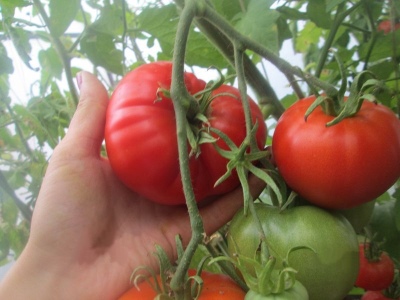
- Authors: Ognev V.V., Korchagin V.V., Tereshonkova T.A.
- Year of approval: 2015
- Category: grade
- Growth type: indeterminate
- Appointment: fresh consumption, for juice, for ketchup and tomato paste
- Ripening period: early
- Ripening time, days: 90-105
- Growing conditions: for open ground, for film greenhouses
- Bush size: tall
- Bush height, cm: up to 170-200
Altai Dawn is an ideal variety for those who love early varieties of tomatoes. The high-yielding culture pleases gardeners with its rich harvests and unpretentious care, and the regions of its growth are so vast that summer residents from all over the country have the opportunity to get acquainted with the variety.
Breeding history
The Altayskaya Zarya variety was bred by such breeders as V.V. Ognev, V.V. Korchagin, T.A.Tereshonkova.The culture was allowed to be used in 2015.
Description of the variety
The described variety belongs to the varieties of the indeterminate type. The bushes reach a height of 170-200 cm and are highly branchy. The leaves are medium in size and green in color. The inflorescences are intermediate.
The main qualities of the fruit
Fruits that are not yet ready for harvest have a color that is close to light green. Ripe specimens acquire a uniform crimson hue. The vegetables are quite large, weighing 300-400 grams, but there are also tomatoes that have grown to 600 grams. The shape of such tomatoes resembles a heart, ribbing is present.
Taste characteristics
Soft and juicy pulp is hidden under the dense glossy skin. It is distinguished by its meatiness and pronounced aroma. The tomato has a classic taste: sweet, but with a slight sourness.
Ripening and fruiting
Altai dawn belongs to the early varieties of tomatoes. The variety ripens in 90-105 days. The culture bears fruit in July or August.
Yield
The plant is quite high-yielding. If you follow the rules of cultivation and care, then 5.8 kg of ripe tomatoes can be harvested from a square meter of soil.
The timing of planting seedlings and planting in the ground
For seedlings, seeds are sown at the end of February or the very beginning of March. It is very important to pre-disinfect the soil by treating it with a solution of potassium permanganate. The seeds are covered with earth by 1 centimeter. Further, the standard rules of care are carried out. If everything is done correctly, in May, the seedlings can be transferred to a permanent place of residence. The variety can be grown both outdoors and in greenhouses.

Growing tomato seedlings is an extremely important process, because it largely depends on whether the gardener will be able to harvest at all. All aspects must be taken into account, from seedbed preparation to planting in the ground.
Landing scheme
Seedlings are planted in warm soil (soil temperature - at least +14 degrees). It should be warm outside. The soil has been prepared since autumn, adding all the necessary fertilizers to it. When planting, you must maintain a distance between plants of 60 centimeters. The same is maintained between the rows. Plants must be tied up, since tomatoes are large in size and can break the bush.

Growing and care
Tomatoes of the Altayskaya Zarya variety are grown in sunny, warm areas protected from the wind. The first time after planting, the culture will need a shelter, thanks to which it can more easily adapt to new conditions.
Watering should be infrequent, but abundant. When fruits begin to form, the gardener will have to spend about 20 liters of water per square meter. If tomatoes are grown in a greenhouse, it must be ventilated after watering, otherwise the air humidity will increase. Tomatoes that grow outdoors are watered 1-2 times a week, depending on the amount of rainfall. A bush needs about 5 liters of liquid. Tomatoes are watered only at the root, it is impossible for the water to get on the fruit or leaves. It is best to take rain or settled liquid. A drip irrigation system is also highly recommended.
After watering is carried out, the soil should be slightly loosened. It is also important to control the amount of weeds. To retain moisture near the bush, you can put mulch made from natural materials.
They begin to feed the plants three weeks after planting. At the stage of active growth, nitrogen is required, but you should not be zealous with its amount. If there is too much nitrogen, the plant will give all its strength to the growth of the tops. Further, the culture will need mineral fertilizer for tomatoes. Top dressing is applied every 10 days, alternating organic and mineral complex preparations.
Do not forget about the formation of the trunk: as a rule, at the Altai dawn it is recommended to cut off the lateral shoots, leaving only one trunk.




A plant needs different micronutrients at each stage of growth. All fertilizers can be divided into two groups: mineral and organic. Folk remedies are often used: iodine, yeast, bird droppings, eggshells.
It is important to observe the rate and period of feeding. This also applies to folk remedies and organic fertilizers.


Growing regions
Altai Zarya can be grown in the following regions:
Northern;
Northwestern;
Central;
Volgo-Vyatsky;
TsCHO;
North Caucasian;
Middle Volga and Nizhnevolzhsky;
Ural;
West Siberian and East Siberian;
Far Eastern.
Review overview
Most summer residents are very happy with the Altai Zarya variety. Being very unpretentious, it gives large fruits of interesting color and pleasant taste. Some gardeners have managed to grow a fruit weighing 1 kilogram. Watering and maintenance is easy, even for beginners.
The disadvantage was that the plant needs to be formed. It is also rare and not always easy to find. Large weight can sometimes be a minus, because the use of such a tomato in cooking will have significant limitations.

























































































